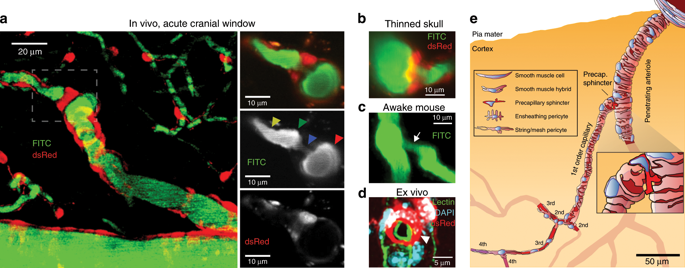当前位置:
X-MOL 学术
›
Nat. Commun.
›
论文详情
Our official English website, www.x-mol.net, welcomes your feedback! (Note: you will need to create a separate account there.)
Precapillary sphincters maintain perfusion in the cerebral cortex.
Nature Communications ( IF 16.6 ) Pub Date : 2020-01-20 , DOI: 10.1038/s41467-020-14330-z Søren Grubb 1 , Changsi Cai 1 , Bjørn O Hald 1 , Lila Khennouf 1, 2 , Reena Prity Murmu 1 , Aske G K Jensen 1, 3 , Jonas Fordsmann 1 , Stefan Zambach 1 , Martin Lauritzen 1, 4
Nature Communications ( IF 16.6 ) Pub Date : 2020-01-20 , DOI: 10.1038/s41467-020-14330-z Søren Grubb 1 , Changsi Cai 1 , Bjørn O Hald 1 , Lila Khennouf 1, 2 , Reena Prity Murmu 1 , Aske G K Jensen 1, 3 , Jonas Fordsmann 1 , Stefan Zambach 1 , Martin Lauritzen 1, 4
Affiliation

|
Active nerve cells release vasodilators that increase their energy supply by dilating local blood vessels, a mechanism termed neurovascular coupling and the basis of BOLD functional neuroimaging signals. Here, we reveal a mechanism for cerebral blood flow control, a precapillary sphincter at the transition between the penetrating arteriole and first order capillary, linking blood flow in capillaries to the arteriolar inflow. The sphincters are encircled by contractile mural cells, which are capable of bidirectional control of the length and width of the enclosed vessel segment. The hemodynamic consequence is that precapillary sphincters can generate the largest changes in the cerebrovascular flow resistance of all brain vessel segments, thereby controlling capillary flow while protecting the downstream capillary bed and brain tissue from adverse pressure fluctuations. Cortical spreading depolarization constricts sphincters and causes vascular trapping of blood cells. Thus, precapillary sphincters are bottlenecks for brain capillary blood flow.
中文翻译:

毛细血管前括约肌维持大脑皮质的灌注。
活跃的神经细胞释放血管扩张剂,通过扩张局部血管来增加能量供应,这种机制称为神经血管耦合和BOLD功能性神经影像信号的基础。在这里,我们揭示了一种控制脑血流的机制,即在穿透性小动脉和一级毛细血管之间的过渡处的毛细血管前括约肌,将毛细血管中的血流与小动脉流入联系起来。括约肌被收缩的壁细胞包围,壁细胞能够双向控制封闭的血管段的长度和宽度。血液动力学的结果是,毛细血管前括约肌可以在所有脑血管段的脑血管流动阻力中产生最大的变化,从而控制毛细血管流量,同时保护下游毛细血管床和脑组织免受不利的压力波动。皮质扩散性去极化会收缩括约肌并引起血管捕获血细胞。因此,毛细血管前括约肌是脑毛细血管血流的瓶颈。
更新日期:2020-01-22
中文翻译:

毛细血管前括约肌维持大脑皮质的灌注。
活跃的神经细胞释放血管扩张剂,通过扩张局部血管来增加能量供应,这种机制称为神经血管耦合和BOLD功能性神经影像信号的基础。在这里,我们揭示了一种控制脑血流的机制,即在穿透性小动脉和一级毛细血管之间的过渡处的毛细血管前括约肌,将毛细血管中的血流与小动脉流入联系起来。括约肌被收缩的壁细胞包围,壁细胞能够双向控制封闭的血管段的长度和宽度。血液动力学的结果是,毛细血管前括约肌可以在所有脑血管段的脑血管流动阻力中产生最大的变化,从而控制毛细血管流量,同时保护下游毛细血管床和脑组织免受不利的压力波动。皮质扩散性去极化会收缩括约肌并引起血管捕获血细胞。因此,毛细血管前括约肌是脑毛细血管血流的瓶颈。



























 京公网安备 11010802027423号
京公网安备 11010802027423号